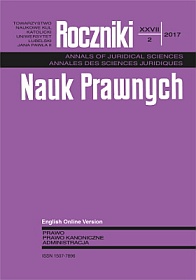The Impact of Major Natural Disasters on the System and the Insurance Market of the Interwar Poland
Abstract
The article is an attempt to present the problem of natural disasters and their influence on the economy and the functioning of the insurance market during the interwar period in Poland. The Author reveals the picture of Poland grappling with a number of challenges such as the unification of the legislation or rebuilding of the economy deteriorated by the war. The country had to increase its expenditure in the aftermath of natural disasters. Poland is presented as a state that had to cope with disasters and various economic turbulences every three years on average. As early as in 1921, the whole territory of Poland was struck by scorching heats resulting in huge loses in its economy, especially in agriculture. Mid 1920s was a period of raging inflation but also a struggle with the flood, which had been the greatest natural disaster in the territory of Poland in over three centuries. The years 1926–1929 were the heyday for the Polish economy, yet Poland suffered the first signs of an economic breakdown in 1929. In the summer of 1928, it had faced a tornado that destroyed houses, obliterated forests and claimed the lives of many. A similar occurrence was recorded in 1931 in the area of Lublin, where a hurricane of unprecedented force ravaged the land. The turn of the year 1929 went down in the history of our nation as the winter of the century. Another flood ravaged Poland in 1934, when the country had not yet fully recovered after the economic collapse caused by the Great Depression. The flood caused losses exceeding 84 million zloty. The Author also presents changes in the legislation of that time forced by the disasters and, above all, the law concerning prevention of fire and other natural disasters. It was a law which owing to the support of insurers enabled fire brigades and fire fighter units to develop so that the general public and its property could be safeguarded against disasters in the future.
References
[no author indicated]. „Niebywale gwałtowny huragan.” Tygodnik Polesie 31 (1931): 4–5.
[no author indicated]. „Rekordy klimatyczne w Polsce.” In Instytut Meteorologii i Gospodarki Wodnej, accessed July 5, 2016, http:www.imgw.pl.
[no author indicated]. Sukces i renoma PZU. Odpowiedzialność społeczna, accessed July 3, 2016, https://www.pzu.pl/relacje-inwestorskie/spolka/odpowiedzialnosc-spoleczna.
[no author indicated], Zagrożenia okresowe występujące w Polsce. Warsaw: Rządowe Centrum Bezpieczeństwa, 2010.
Dąbrowski, Marian. “Trąba powietrzna w Lublinie.” Tygodnik Ilustrowany Światowid 31 (1931): 6–7.
Fal, Barbara. “Powódź Tysiąclecia?” Wiedza i życie – pismo o nauce 10 (1997): 14-17.
Grunke, Paweł. “Tegoroczna powódź wiosenna.” Słowo Pomorskie 81 (1924): 3.
Gumiński. Romuald. “Zima roku 1928/29 w Polsce.” Przegląd geograficzny 11. Warsaw: Polskie Towarzystwo Geograficzne, 1931.
Kienzler, Iwona. Katastrofy i klęski żywiolowe, Dwudziestolecie międzywojenne 40. Warsaw: Bellona, Edipresse Polska, 2014.
Klusek, Wojciech, and Ewa Pajuro. “Największa nawałnica w historii Polski przeszła nad Lublinem.” Kurier Lubelski, July 21, 2011. Accessed July 5, 2016, http://www.kurierlubelski.pl/artykul/ 430028,najwieksza-nawalnica-w-historii-polski-przeszla-nad-lublinem,id,t.html.
Knyt, Agnieszka. 200 lat ubezpieczania 1803-2003 geneza powołanie czas. Warsaw: Wydawnictwo Karta, 2003.
Kowal, Józef. “Ustawa o ochronie przed pożarami i innymi klęskami.” Przegląd Ubezpieczeniowy 2 (1934): 3–9.
[no author indicated]. Memoriał w przedmiocie projektu ustawy o ochronie przed pożarami i innymi klęskami żywiołowymi. Warszawa: Związek Prywatnych Zakładów Ubezpieczeń w Polsce, 1934.
Mężnicki, Witold. “Klęska powodzi na Podhalu.”Gazeta Gdańska 158 (1934): 1.
Mężnicki, Witold. “Na drodze do skutecznej walki z klęską pożarów.” Gazeta Gdańska 153 (1934): 3.
Montalbetti, Edward. O dalszy rozwój publicznych ubezpieczeń od ognia. Warsaw: Drukarnia Matematyczna H. Zajączkowski, 1938.
Pieniążek, Kazimierz. “Katastrofalny huragan przeszedł nad Lublinem. Straszliwe skutki trąby powietrznej.” Ziemia Lubelska 195 (1931): 1.
Pieniążek, Kazimierz. “Obliczanie strat spowodowanych żywiołową katastrofą w Lublinie.” Ziemia Lubelska 196 (1931): 1.
Poturalski, Józef. “Dni mrozu.” Gazeta Morska 9 (1929): 1.
Poturalski, Józef. “Fabryka Stetysz spłonęła.” Gazeta Morska 9 (1929): 2.
Poturalski, Józef. “Ogromne zatory lodowe w Zatoce Gdańskiej.” Gazeta Morska 10 (1929): 5.
Skrzyczyński, Wilhelm. “Około 500 budynków padło ofiarą huraganu w jednym powiecie.” Słowo Polskie 190 (1928): 2.
Szczęśniak, Marian. Zarys dziejów ubezpieczeń na ziemiach polskich. Warsaw: Przedsiębiorstwo Wydawnicze LAM Sp. z o.o., 2003.
Szelichowski, Stanisław. Dzieje polskiej motoryzacji. Łódź: Księży Młyn Dom Wydawniczy, 2012.
Zasoby wodne w dorzeczu górnej i środkowej Odry w warunkach suszy. Ed. A. Dubicki. Instytut Meteorologii i Gospodarki Wodnej Atlasy i Monografie, 2002.
Copyright (c) 2017 Roczniki Nauk Prawnych

This work is licensed under a Creative Commons Attribution-NonCommercial-NoDerivatives 4.0 International License.


